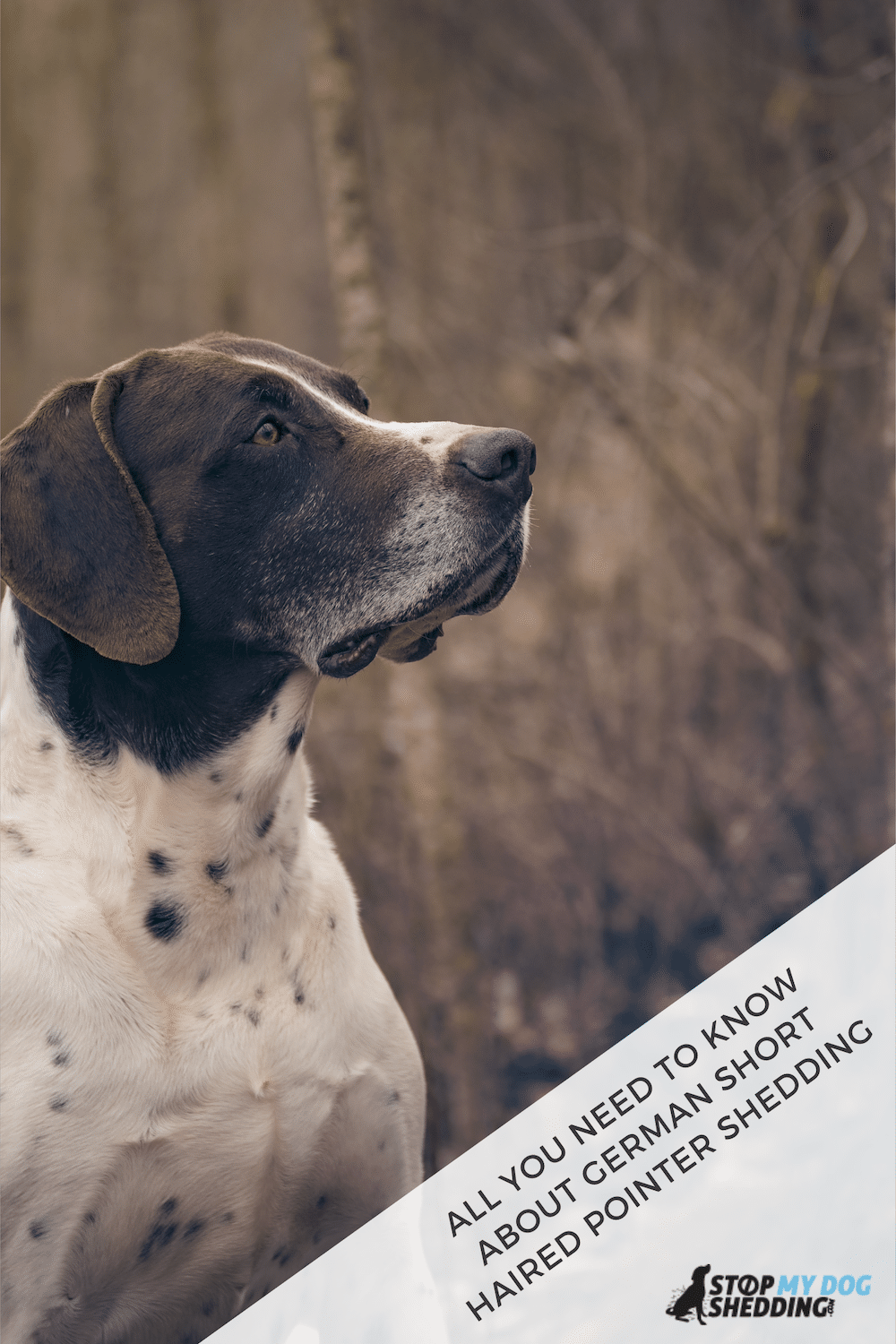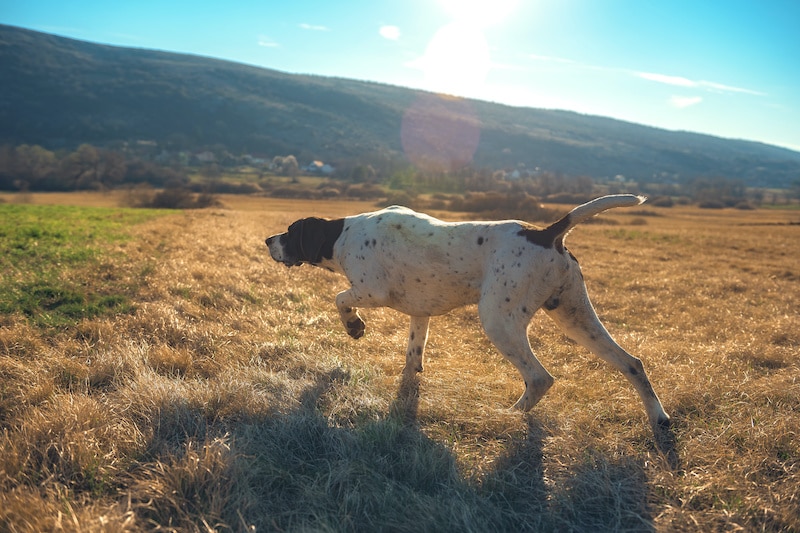The German Shorthaired Pointer is a fun, high-energy dog that makes for a great all-around companion. They are good with children and enjoy playtime whenever they get the chance.
On the same token, they are purpose-bred hunters.
They were originally bred in Germany in the late 1800s as hunting dogs and belong to the pointing breed. A ‘pointer’ is characterized by their instinct to spot and point towards game with their muzzle.
So they’re a very versatile breed and one that needs lots of exercise and attention.
How much hair do they shed? German Shorthaired Pointers are considered low-to-moderate shedders, and given their short coats, they are very low-maintenance dogs too.
Ahead, I’ll show you what you need to know about the shedding and grooming characteristics of a German Shorthaired Pointer to help you decide if this dog’s right for you.
Recommended: Go here to see our top-rated dog hair blow dryers
The German Shorthaired Pointer’s Coat
The adult German Shorthairs coat is short, thick, and coarse. Although it is a lot smoother around the head and ears as with most dog breeds.
The coat colors in this breed include solid liver (deep brown), black and white. Or a combination of liver and white, or black and white. His coat is often ticked, patched, or roan, or a variation of these.
Ticking on a coat is small markings of color over a white background. While patching is essentially just a larger version of these markings. A roan coat is a fine mixture of both color and white hairs throughout.
They also have a dense, water-resistant undercoat too, which keeps them warm and dry in the colder weather. This has a direct impact on his overall shedding, especially at certain times of the year, like spring.
German Shorthaired Pointer (GSP) Coat

| Coat type: | Double coat |
| Texture: | Thick and coarse |
| Length: | Short hair |
| Color: | Solid liver, black, white, or black and white / liver and white. Ticked, patched, or roan variations. |
| Shedding: | Low-to-moderate shedding |
| Grooming: | Low-maintenance |
German Shorthaired Pointer Shedding
The German Shorthaired Pointer is a low-to-moderate shedder.
Many people assume that short hair dogs do not shed or shed a lot less. But this is simply not the case. All dogs shed at least some hair.
In the case of a shorter hair breed, it’s often a case of not being able to notice the shedding as much as you would with a longer-haired dog.
In any case, German Shorthairs are not heavy shedders. Which is good news! The only caveat here is that smaller hairs can be more difficult to remove from carpet and upholstery.
It’s also worth noting that the undercoat plays a part in how much hair he will shed and when. GSPs will typically ‘blow coat’ during seasonal (and hormonal changes), the former of which is common among double-coated breeds.
As long as you’re aware of this and are proactive about it, this shouldn’t be an issue, though. There are some very practical ways you can reduce shedding. For example, diet, regular bathing, and brushing all play a part in keeping the shedding as low as possible.
Recommended: Go here to see our top-rated dog hair blow dryers
Grooming Your German Shorthaired Pointer
Looking after your GSPs coat is simple in comparison to many other breeds. And maintaining a good grooming schedule is one of the best ways you can reduce shedding.
When bathing, a quality dog shampoo is best. As it will not contain harsh chemicals, and it won’t strip your dog’s coat of its natural oil. Bathing once or twice per month should suffice. Try to avoid over bathing, however, as this can cause skin irritation, which can lead to excessive shedding.
Brushing your dog should be a daily routine if possible. Not only will this remove loose hairs, but it will help to spread the natural oils throughout his coat.
Using a firm bristle brush, fine tooth comb, or a rubber hand mitt will get the job done.
As long as you are gentle and take care to use the right brush, this is one of the most practical ways to reduce excessive shedding. It’s also a great way to bond with your companion!
Bottom Line
German Shorthaired Pointers are low to moderate shedding dogs, and they’re easy to groom. Maintaining their coat and reducing shedding is simple and mostly comes down to a good diet and regular grooming. So if you’re looking for an awesome, low-shedding, easy-to-groom pointing dog, the GSP may be just what you’ve been searching for.













We have an eight-year-old predominantly liver-coloured GSP, well – at least he used to be. After several years lying on the back porch in the hot Australian sun he is now a rather horrible shade of copper/orange and the hairs are quite dry and rough. We use a professional shampoo and he has a shower 4 or 5 times per week when he gets back from the beach. He recently had a small patch on his side shaved for some stitches. That patch has now grown back beautifully soft and deep brown. I asked my vet if we should shave him completely and she looked at me as if I was mad. “No!” she said. Any reason why not? Or any other way of making him brown again?
Hi Neill,
The first thing I would say is that I am not a veterinarian, so I can’t give you any personal advice about your dog, nor can I speak to your vet’s specific reasoning on the matter.
That said, I do know that it’s typically not a good idea, except if your vet recommends it for a medical reason, to shave a double coated dog – which GSPs are. Reason being, a dogs undercoat protects them from both hot and cold weather alike, so removing it can expose them to temperature extremes. Not to mention, shaving any dog, single or double coat breed, exposes them to potential sunburn, mosquito bites and so forth. You can learn more about the difference between single vs double coated breeds here.
With respect to the dryness you mentioned, the first thing I would do is ask your vet if it’s a good idea to be shampooing your dog 4-5 times per week, because that seems excessive to me, and even good shampoos can dry out your dog’s skin and hair. I would also research and ask your vet which dog food is optimal for your dog, because some dog foods are richer in things like marine sourced Omega 3 which may help improve your dogs skin and hair. You can see our top 10 rated dog food here.
With respect to the color of your dog’s coat, with regular brushing, the old hairs should naturally fall out so that new hairs can take their place over time. So, provided your dog is healthy, is enjoying an optimal diet, and isn’t spending too much time in the sun, I personally don’t see any reason to shave him to regain the natural beauty of his coat.
Thanks for commenting and all the best.
Nonsense. Shaving a dog had almost zero ill effect, for any breed…
Thank you for commenting. As we mentioned, we don’t recommend it either; however, we always recommend discussing things with your vet, of course! The natural hair coat a dog comes with generally is there to provide many benefits, so our site aims to help readers make the best of it, while also keeping your environment a bit more tidy. Thank you again for reading and commenting. We love dog lovers! Sorry for the delay here.